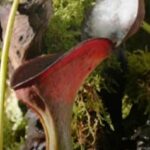As an Amazon Associate, this site earns commissions from qualifying purchases. For more details, click here.
If you are having gnat problems at home you are not alone. Practically everyone who has cultivated plants has or will run into this situation at some point. These insects are quite harmless but can be a real nuisance for plant growers. Can pitcher plants be the answer? Will growing several of these in your garden finally get rid of these pesky little bugs?
Pitcher plants eat gnats but it is not a big part of their diet. These plants often prey on ants, beetles, wasps and foraging bugs. Sundews and butterworts are more likely to capture gnats and do a better job keeping them at bay.
Can You Give Gnats to Pitcher Plants?
You can feed gnats to nepenthes, sarracenia or any pitcher plant. These plants can also attract these bugs on their own if outdoors.
Manually feeding gnats to pitcher plants is difficult because of their size. The fact is most people want pitcher plants to eat these bugs to get rid of them. However, pitcher plants are not exactly the best natural gnat controllers out there.
Ready to Grow Carnivorous Plants with Confidence?
Stop guessing and start thriving. Whether you’re raising flytraps, sundews, Nepenthes, or butterworts, this visual-first guide gives you everything you need — from lighting and watering to feeding and seasonal care.
- Beginner-proof diagrams
- Step-by-step routines
- Instant PDF download

What carnivorous plants eat depends on their environment, specifically what is available and suitable. Venus flytraps for instance, usually eat spiders and other crawling bugs because they are prevalent and contain the nutrients the plant needs.
Sundews and butterworts feast on flying insects like gnats, moths and fruit flies. Pitcher plants meanwhile, prey on foraging insects like beetles, wasps, houseflies etc. Their traps are fine tuned to catch insects in their habitat, so they are more likely to go after these.
This does not mean pitcher plants cannot eat gnats, because they can. You can drop a gnat in a pitcher and it will be digested. However, they are a less common nutrient source compared to other foraging insects.
It comes down to their environment. Ants are common prey for nepenthes because they share the same habitat. The nectar produced by pitcher plants also draw ants which makes them a good source of nutrition. This same liquid is also used to draw other types of bugs, though it does not lure gnats as well as others.
Bottom line; pitcher plants will eat gnats given the opportunity. But they prefer to eat other bugs. Even if you do get the plant to eat gnats, it takes them a while to digest everything.
How Many Gnats Can Pitcher Plants Eat?
Gnats are so small it is tempting to just stuff the pitcher full of it. If you have a fungus problem, can you fill each pitcher with gnats? The liquids in the pitchers should be able to drown these bugs right?
Pitcher plants typically eat four bugs a month. It takes about one week to fully digest an insect and the plant will not eat again until its nutrients are depleted. In fact there are pitcher plants which thrive even with once a month feeding.
Feeding gnats to pitcher plants is very difficult. If you have gnats in the garden it is probably scattered around your plants and you are looking for a way to get rid of them. Feeding them to pitcher plants manually is not easy, but will these bugs willingly go over to the plant?
One of the reasons sundews are so effective is their trapping mechanism works very well for gnats. Pitcher plants have their own method of trapping bugs. This works well with gnats too, but in general, it attracts ants, beetles and other insects.
If you get your hands on several gnats, how many can you give the plant? It depends on how many times your plant has fed. The good news is you can put several gnats in the pitcher, but the plant will not digest those if its nutritional quota has been met. If you feed nepenthes with Kaytee Koi’s Choice Floating Fish Food regularly for instance, it does not have to eat a lot bugs because it gets enough nutrients.
If for example your nepenthes has already had its fill, those gnats will just remain in the pitcher. The plant will not digest the bugs until it requires additional nutrients.
It might seem like a good idea to leave bugs in the pitchers so the plant does not have to catch any more prey. However these insects could decay and create a stink. This could also attract fungus and even turn the pitchers brown.
Can Pitcher Plants Control Gnats?
Pitcher plants eat a lot of insects, and you have probably heard they are pretty good in keeping fruit flies away. But what about gnats? Are these pitcher plants natural gnat repellents?
Nepenthes and sarracenia pitcher plants can digest gnats, but only in small amounts. They are not effective gnat controllers because it takes them a long time to process and digest bugs. Once pitcher plants have absorbed enough nutrients, they will not eat anymore.
Sundews and butterworts attract and consume more gnats. But even so this is only a temporary solution. if you have a large gnat problem, you have to look for the source and eliminate it.
How to Get Rid of Gnats
- Gnats are usually found in rotting food, moist, dark places and garbage cans. They usually infest decaying organic material. Clean these up and your fungus gnat problems will be reduced.
- Buy gnat sprayer online. There are a lot of products available to choose from such as Summit Gnat Spray. Make sure the spray is safe for your plants and follow directions for its use.
- Fill a bowl with apple cider vinegar, water and sugar. Place it near where the gnats are. They will crawl into the mix and drown.
- Gnats are not capable of harming pitcher plants. However they can be an annoyance. Be careful when getting them off your plants to avoid damaging the leaves.
These are just some of the methods you can use to get rid of gnats in your home. If there are only a few of these, sundews or pitcher plants will be enough. But you should not rely on carnivorous plants to fix a large scale problem.
How Do Pitcher Plants Eat Gnats?
Pitcher plants come in different forms, shapes and colors, but their method for catching prey is very similar. The following applies to nepenthes, sarracenia and other species.
The pitcher is made up of leaves. The interior walls and the edges are coated with nectar moisture. This moisture keeps the surface wet and produces a smell to lure prey. Since pitcher plants are immobile, they have to produce this scent to make the bugs come to them.
When a bug smells the nectar, it lands on the edge of the pitcher. However, the moisture causes the bug to lose its balance and fall in the pitcher. Some pitcher plants have a leaf atop the pitcher, serving as a platform where insects can land.
This lid is not only wet, but it also produces vibrations when struck by water. So if an insect lands on the leaf and droplets fall on it, the leaf will vibrate and send the insect hurling down into the pitcher.
Inside the pitcher are liquids (including water) that will trap the prey. The liquids drown the bug, prevent it from flying or climbing back up and just make sure it stays trapped. Eventually the prey will expire from suffocation or drown.
Some pitcher plants have insect larvae or bacteria mixed in the liquid. These are necessary to help the plant break down the insect tissues. In addition, pitcher plants will release digestive fluids to further dissolve the insect.
Pitcher plants will start digesting the prey slowly. This could take a long time depending on the size and how much energy the plant has. Eventually the pitcher plant will consume the insect in its entirety. You may probably see some leftover bits in the pitcher.
Conclusion
While pitcher plants are capable of eating gnats, it is not going to solve a large scale problem. If you just want to feed your plant with gnats that is fine. But if you have a fungus gnat problem, it is better get sundews, set up sticky traps or call a professional pest controller. Pitcher plants are best suited for getting rid of the occasional gnat only.

My fascination with carnivorous plants began many, many years ago with Venus Fly Traps. Now I am more than happy to impart what I know with other enthusiasts and those who are curious about meat eating plants.



